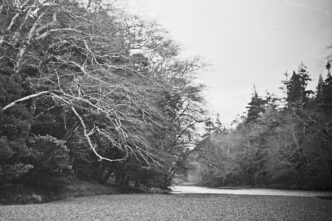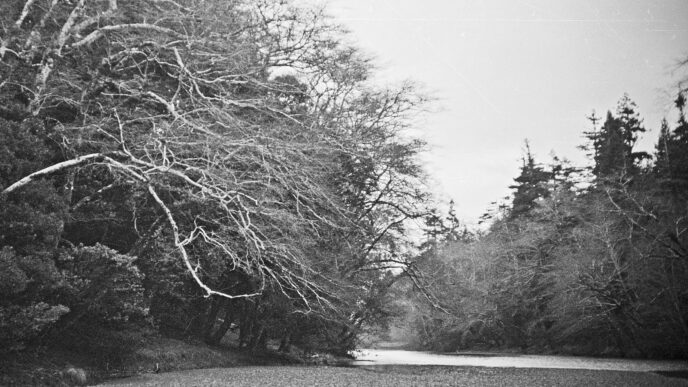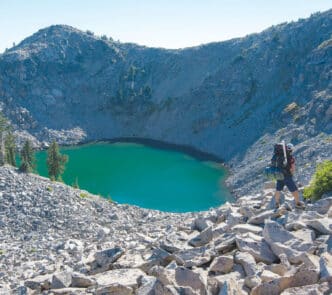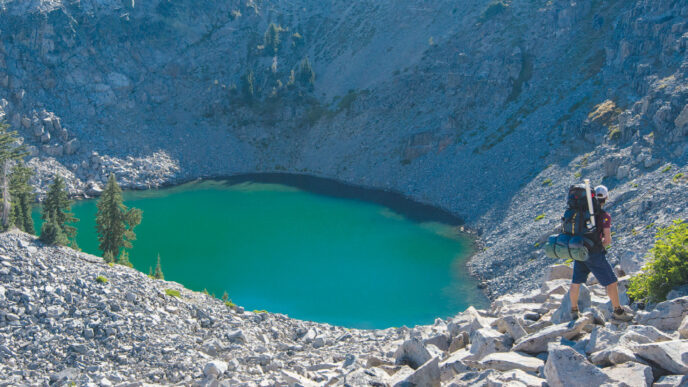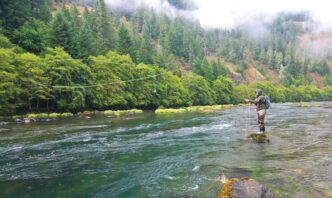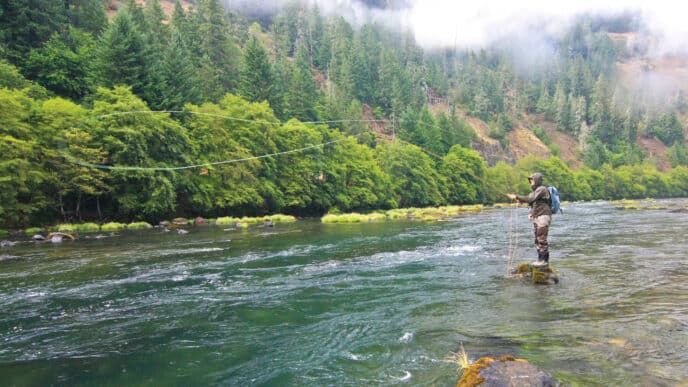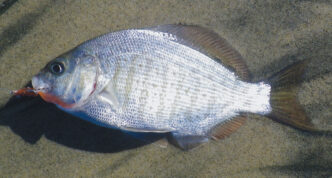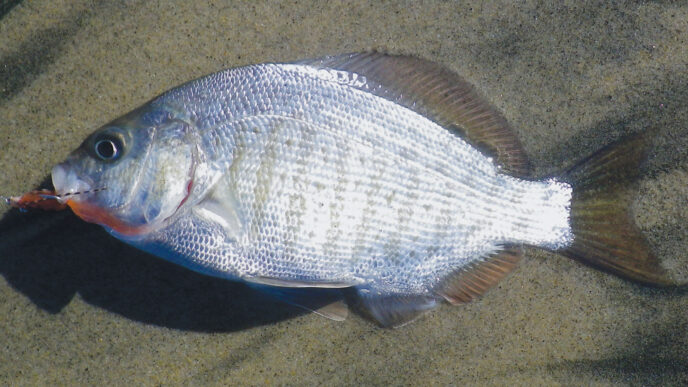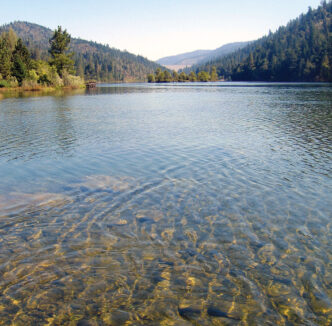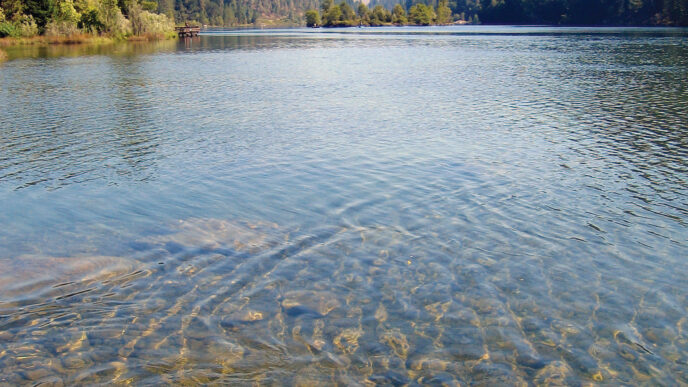Beef Bourguignon, Tri-Tips, and Other Camping Delights
With Trent Pridemore
Our 165-member Gold Country Flyfishers club in Grass Valley–Nevada City has grown exponentially in the past decade. This is due in part to the dedication of local members who hung in through some lean years, but also to an influx of experienced retiree emigrants like me, who often have connections with clubs elsewhere in the state. The result has been a dynamic group and lots of good times. Our angling assets include the Yuba, Feather, American, and Bear Rivers on the west slope, as well as the Truckee and Little Truckee Rivers, and the Carson and Walker a bit farther south on the east slope. We also know the best stillwater venues in all directions. Because of our large size for a rural club, our budget not only allows us to bring in speakers from around the state and to provide clinics and outings, but it means that we can expect fabulous barbeques for our outings. Each year, we schedule some 15 or so “fishouts” that range from our local waters to as far north as the Fall River and as far south as the Delta and Lake Amador. Our best-attended outings are at Frenchmans Reservoir and Lake Davis. These sizeable impoundments and the campgrounds there accommodate many anglers without pressure. We love these lakes for their scenery, productivity, and the camping facilities, which give us the ability to have great campfires and group meals at least once during a gathering.
I have studied the history of the American West and particularly like the idea of the “rendezvous” that early mountain men held each year. I think that all of us, secretly or otherwise, fantasize about gathering annually with our peers to share tall tales, outdoor meals, and raucous behavior. Spring rituals and fall harvest festivals abound worldwide, so why not angling festivals at a favorite lake?
We gather at Lake Davis in the late spring to try to catch the damselfly migration and again in early fall at Frenchmans, hoping for Callibaetis sight fishing, a blood midge hatch, or other chironomid activity. A purpose of no lesser importance than finding great angling, however, is the camaraderie experienced around the campfire and during communal meals under the tall trees. This past year, our Fishmeister hit the nail on the head by selecting the dates of June 16 through 19 and September 6 through 9, but it was very cold on some of those evenings. The temperatures made the campfire even more welcome.
It is not easy to cook for a large group in a campground. On past outings, we’ve prepared New York steaks, Spanish pork with white beans, and piquilla pepper stew and grass-fed goat on a spit. This year, we cooked our springtime festival’s final feast on a round Forest Service campfire ring and on one of those iron campsite barbeques with a square iron grid that flips down from the side, although I also brought a stainless grill to put on top. We combined seasoned oak and charcoal briquettes to get an even, flavorful coal base. I had bought tri-tips at Costco two days earlier and immediately had put them into Ziploc bags with a hefty dose of a favorite red wine vinegar, herb-based proprietary Basque marinade, and garlic salt. Jimmie Marchio, fire boss extraordinaire and barbeque expert, handled the meat on the grill. We took internal temperatures and lifted the beef off at 130 degrees into commercial stainless steel pans, covering them with foil to rest for 10 minutes, all in the flickering light of a roaring campfire. There was some char on the outside, but as famous Argentine chef Francis Mallman says, “a little char is OK.”
We solved the logistics problem by asking members to bring a potluck dish and portable tables. Another member found an active farmer’s market roadside produce stand on the way up, near Beckwourth, and bought 40 ears of corn, which we dressed with Wishbone salad dressing and wrapped in foil. The corn went into the fire ring’s side areas while we grilled the tri-tips over the hardwood charcoal on the limited grill space. We live in the Sierra foothills, so a number of us brought favorite vintages from there to share.
Another member, Rick Aeschliman, a professional musician and artist, set up a portable sound system and played hauntingly beautiful flute and guitar music under the trees while we barbecued, gobbled appetizers, drank good wine, and dug our forks and knives into juicy medium-rare grilled beef and twenty or so side dishes. We had to ration servings until all went through the line once.
In September, low water and campground closures at Frenchmans moved us back to Davis, which wasn’t a bad decision, because the lake is fishing the best it has in years. Our angling was again good, but also a bit more hit and miss this time, because the lake was experiencing an early turnover.
Many in our group quit fishing an hour early on Friday because they knew a superb meal was in the works and that camp help was needed. One of our members is CEO and president of the Cattlemens Restaurant chain. He brought chef Sean Campbell from his Roseville restaurant, who wanted to try stillwater fly fishing. Sean in turn brought a two-burner propane high-BTU cook stand such as you find in Cabela’s or Bass Pro Shop catalogues, chef knives, huge skillets, and several large stainless steel stock pots and a professional cutting board. His camp dish for 15, plus a few camp followers and a dog or two, was a slow-cooked tri-tip beef bourguignon served over a creamy cheese polenta.
Aromatics, olive oil, herbs, several secret ingredients, and lots of very good red wine (some said two bottles) went into the dish, which was simmered all afternoon. He served it with a broccoli tip salad and garlic bread. I marveled at the ease with which he put together this great meal in unfamiliar surroundings on a wooden Forest Service camp table.
Chef Campbell’s Beef Bourguignon with Creamy Parmesan Polenta
3 pounds tri-tip with most of the fat removed and cut into inch-by-inch-and-a half chunks
35 button mushrooms 1/2 white onion, diced
1/2 jalapeño, ribs and seeds removed, diced
2 stalks of celery, diced
3-ounce package of au jus gravy mix, mixed with eight cups of water
1/2 cup cornstarch
1 bottle of drinkable red wine
6 cups milk
3 cups of corn meal or polenta
1 cup grated Parmesan
4 tablespoons of olive oil
Season the tri-tip and mushrooms with salt and pepper and sear till dark brown in olive oil in a large stock pot. Set aside. In the same pot, add two tablespoons of olive oil and sauté the onions, jalapeño, and celery until soft. Deglaze the pan with half a bottle of good red wine and add back the tri-tip, then the au jus mix and water. Bring to a boil. Combine the remaining wine and cornstarch to make a slurry and slowly add it to the tritip pot until the liquids thicken. Reduce the heat and simmer for around an hour and a half.
For the polenta, boil six cups of milk and stir in three cups of polenta and one cup of Parmesan. Reduce the heat and simmer on a low burner for 20 minutes, stirring often. The cooking time may vary with altitude, and you might need to add a bit more liquid.
Beef or veal demiglace can be substituted for the au jus. Don’t use a wine that you wouldn’t drink, but it needn’t be expensive. Some fruit forwardness works best for full flavor.
Serve the beef bourguignon over the creamy polenta and garnish with Italian parsley and more Parmesan.
The Log Cabin in Portola
A recommendation from Trent Pridemore
The Log Cabin has been an institution for many years in Portola. On any given night, you could find just about anybody you were looking for at the bar, whether it was a Fish and Game biologist, the town judge, a Five Dot Ranch cowboy in town looking for a decent meal and company, or locals complaining about the situation at Lake Davis. I’ve sat at that bar since 1972 and the glory days of the lake, even taking a few turns around the dance floor to the tunes of the bar’s jukebox. During the most recent economic debacle, the place fell on hard times for a variety of reasons and closed. This year, new owners Kelly and Billy Money took over and cleaned the place up. It now has a rustic country charm and sparkles, as do a restaurant staff who aim to please. A vintage rustic wooden bar, complete with knotty pine and varnished, peeled log beams, complement the wooden canoe that helps separates the bar from the dining area.
My wife and I tried it on the second night after their grand opening this past June. Before we could close the front door, the new hostess, Shannon, made us feel at home and attended to our every need. We found the prices of various entrees to be very reasonable, and on the several times that we have visited, we enjoyed our meals very much and also ran into old friends. That first night, the Log Cabin’s liquor license wasn’t complete, so there was no corkage fee on the bottle of wine that we brought. Corkage now is very reasonable.
The great thing is that the restaurant is seven miles from Lake Davis and is open until 9:00 every night except Tuesdays, when it is closed. This gives late anglers a shot at a decent meal if they don’t feel like cooking. If I’m doing a one-night turnaround, without bringing cooking gear, that’s a godsend. After a long day’s fishing, I favor a plate-filling medium-rare rib eye with a baked potato and some perfectly sautéed vegetables, paired with a house salad. On chilly mornings, I slide out of my truck and gobble the leftover rib eye and potato skin before hitting Grizzly Country Store for coffee and heading for the lake’s west shore. The pasta is good at the Log Cabin, too, as are the chicken dishes. We are happy that the Log Cabin is back and better than ever.
The Log Cabin Restaurant is at 64 East Sierra Street, Portola. Phone (530) 832-4400. Credit cards are accepted. They have a full bar that opens at 3:00 P.M. The restaurant is open for dinner six days a week, 4:30 to 9:00 P.M. (it is closed Tuesdays), and is open for lunch on Saturday and Sunday at 12:00. The owners may open earlier for weekend brunch in the future. Bar food and entrees to $30. As always in resort areas, call to check the hours of operation.
Off of I-5
Two recommendations from Larry Kenney
My friend Susie and I were pulling into a parking space at Bartel’s Giant Burger in Corning (due west about 250 yards off the I-5 Corning exit) when Chris waved to us from one of the outdoor tables. He was coming back from the Trinity, we were heading up to Fall River. Corning’s an easy run from either if you live in the Bay Area and Bartel’s is the best burger in the north valley. There’s nothing fancy there: just big, solid, fresh-made burgers (or Polish dogs or grilled chicken sandwiches for the weak minded), along with
thick shakes, crisp fries, and the usual selection of soft drinks. A giant cheese burger garnished with red onion, lettuce, and tomato is $5.10. Ask for it medium rare or medium well and you get it that way. A couple of extra bucks adds a few thousand more happy calories in the form of bacon, Ortega chiles, or extra burger patties. A chocolate shake and a large order of fries adds another $5.50. Order at the counter inside and grab a table outside in the summer, or sit inside when things cool off. Get your partner to drive while you sleep it off. Chris also turned us on to Roberta’s Taqueria in Williams, a couple of blocks west of I-5 at the corner of 5th and E Streets. This is solid, well-prepared Mexican food including terrific burritos, a handful of different tacos, tostadas and tortas, along with quesadillas and a few larger plates like chile rellenos with rice and beans. Order at the window and wait for your number to be called, which will be a few minutes as the gal who takes the order also does the cooking. There’s no indoor service, but in good weather the outside tables are fine. Had I not halffoundered on a football-sized chile verde super burrito I’d have sampled the terrific looking tacos the two local guys at a nearby table were wolfing down. Next time for sure. $10 or less buys you a meal fit for whatever you imagine yourself to be.
Menudo is available on Saturday and Sunday mornings from 8 A.M. to 11 A.M. for the courageous.
Burgers in Truckee
Installment 4: Cottonwood Restaurant & Bar
By Richard Anderson
The forecast for the evening called for wind and rain, maybe even snow. Usually I love to hunker down in the kitchen during weather like this, preparing a long braise that’ll both warm the house and fill it with wonderful aromas. This night, though, I had returned home late from a meeting, and neither Carole nor I had the energy to cook. Time for a favorite winter option. “Feel like hitting Cottonwood?” I asked. She grinned. “Let’s go!”
Cottonwood Restaurant, a low-slung, rustic building that housed one of the earliest ski lodges in California, sits on a bluff just south of downtown Truckee. Its outdoor deck overlooks the community’s historic district, which makes it a favorite spot for locals and visitors during the summer. In the winter, the main dining room provides the same view, and it is very pleasant to sit at one of the windows and watch the snow swirl down from darkness and into the light. When the weather turns cold, though, Carole and I actually prefer dining at one of the tables in the bar, which is small, intimate, and usually warm with conviviality. The worse the weather outside, the cozier the place feels.
When we arrived this evening, the bar was three-quarters full, and we were able to get a table with no wait. Our usual routine is to start with an iceberg lettuce wedge salad ($11) that we split, followed by cheeseburgers ($14). The menu says these are made with “Meyer Ranch” grassfed beef. Whatever their cows are eating, I approve. When prepared medium-rare, the patty — I’m guessing roughly a half-pound in weight — is juicy and delicious and accented with a hint of char from the grill. Other than a melted slice of cheese, it comes undressed, with mesclun, red onion, tomato, and dill pickle on the side. Mustard and catsup are provided as condiments, and Carole likes to ask for ranch dressing, too. The lightly toasted bun, neither too large nor too small, is perfectly sized for holding everything in place as it all is conveyed to the mouth.
As I type these words, I realize that I don’t know what type of cheese tops the burger. It is orange. I like it. The rest of the plate, by the way, comes filled with waffle fries. This is a meal that satisfies both tongue and belly, and that is worth its price. (Which drops to $11 during the happy hour that ends at 6 P.M.) Carole and I often take half our burger and fries home for a meal of leftovers the next day.
Cottonwood is also known for a number of other dishes, including an excellent whole-leaf romaine Caesar salad ($8, prepared with a dressing made as it supposed to be, with egg yolks). I’m likewise partial to the caramelized Brussels sprouts as a starter ($12), which I sometimes order to share with friends.
The staff of the bar and the dining areas are well-trained and professional in their attention to the clientele, and those working in the kitchen are clearly talented. One qualifier, though: if the restaurant is busy, burgers might not always arrive prepared as ordered, but this is true for every fine burger place in Truckee. Such is the price of popularity. Cottonwood Restaurant & Bar is located at 10142 Rue Hilltop Road, just off Brockway Road near downtown Truckee. For reservations (not available for the bar), phone (530) 587-5711. You can check out the menu and restaurant at woodrestaurant.com. It’s open seven days a week, from 4:30 P.M. to 10 P.M. Live music is offered some evenings, and there’s a nice cocktail list, if you want to commiserate after a slow day on the water.
Flies for Lake Davis
Although our fly club’s communal meals are an important component of our fishouts, the focus is, of course, angling, Readers might therefore like to know that during spring, our most successful fly patterns at Lake Davis have been small, light olive damsel patterns, Phil Fisher’s UV purplish Callibaetis nymph, as well as Denny Rickard’s Stillwater nymph and a small midge trailer like the late Don Stahl’s Pine Creek Special, all fished on clear intermediate lines. In the fall, we tend to do well with Jay Fair’s rusty-colored Wiggle nymph and Denny Rickard’s olive and brown Stillwater nymph trailed by the Zebra Midge (with a dorsal strip of green Krystal Flash) and again that Pine Creek Special. During our spring and fall outings, we tend to find most fish over a weedy bottom in the 8-foot to 12-foot depth — hardly surprising as this tends to be a very productive food zone for trout.
Trent Pridemore







